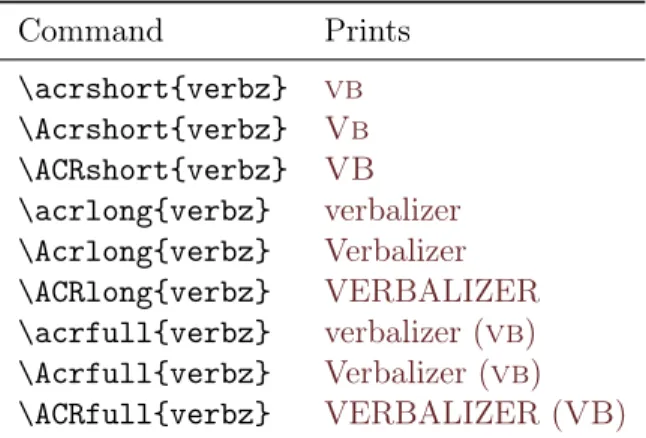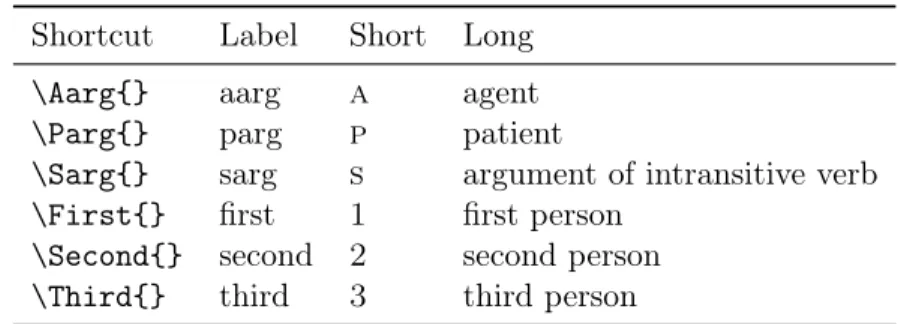Installation
Document structure with glossaries
Print glossaries \printglossaries will print all defined glossaries. printglosses is provided by leipzig and will only print a glossary containing gloss abbreviations. If you have a lot of interlinear glossary examples in your paper, translation can be slow because each instance of a glossary entry has to be written to the glossary. The main part of the package provides a method for defining new gloss abbreviations and shortcut macros for printing short forms of the abbreviations.
For best results, gloss abbreviations should be defined in the preamble after\makeglossariesand before\begin{document}. The reason for this limitation is that leipzig uses the label to create a shortcut macro, so the label must be expandable to a valid control string name. hshortii is the short form of the abbreviation. I recommend typing this argument in lowercase as well and using the wordlist package to format the wordlist so that the first letter of all long forms is consistently uppercase or lowercase.
To redefine a macro, use \renewleipzig with the shortcut label you want to redefine. If the dictionaries are not loaded, the macros print the short form of the abbreviation to \leipzigfont, which is initialized to \textsc.
Pre-defined abbreviations
Shortcut macros take no arguments and swallow a trailing space, so they require braces; you can write either \Label{} or {\Label}.1. The macros that print the person and number abbreviations were defined using \newcommand, not \newleipzig, as in (6). The reason is that each glossary entry must correspond to one component of a fusion gloss, not the entire fusion gloss itself.
Font and display
This can appear anywhere in your document and affects the short forms of the following abbreviations, e.g. Note that the name of each glossary entry will also be printed with the final \leipzigfont redefinition. This is a global setting and affects all acronyms defined with \newacronym (not just gloss abbreviations).
For example, the command in (10) will cause the short form to be displayed in bold and \leipzigfont on first use. To reset the first use flag so that the next use of \gls will display the abbreviation as on the first use, use \glsreset{hlabeli} for an individual abbreviation, or \glsresetall to reset all abbreviations. Besides \gls, there are other acronym-specific macros to print components of the acronym without modifying the first-use flag.
Any modification to \firstleipzigfont will affect any type macros\acrfull; Macros of type \acrshort will not be affected.

Hyperlinks to the glossary
Explicitly formatting individual abbreviations
The short (c) and long (class marker) forms are called in text via commands like \acrfull,2, but the glossary entry will be printed with the name (c#) and description (class marker (# = class number)) fields. . To display the glossaries, put \printglossaries (or the leipzig-defined .. printglosses \printglosses) in your document where you want the glossaries to appear. printglossaries prints all glossaries in the order they were defined, while \printglosses only prints the \leipzigtype glossary. The simplest is to use one of three leipzig package options: [mcolblock]. sets theleipzigmcolalttreestyle, [block] sets theleipzigalttree style, and [inline] sets the inline style.
You can also specify the style in an optional argument to \printglosses (or any of the \printglossary commands). For example, the code in (14) will only print the dictionary \leipzigtype and use the block style. If you want to use your own style defined via\newglossarystyle, then you should use this method. 2If you specify the name field, then \gls will no longer print the long and short forms.
If you have multiple glossaries (eg glossaries that are not glossary abbreviations), the style of the other glossaries is controlled in "normal".
Display options for all styles
If you have multiple dictionaries (eg dictionaries other than gloss abbreviations), the style of the other dictionaries is checked to "normal". style for the glossary package: or use \setglossarystyle before. makeglossaries, or you can use the [style=hstylei] package option.
Options to modify pre-defined styles
Inline glossaries
Note that this condition is set to true for any other dictionary defined.) To print a vertical space between groups of abbreviations, set \glsnogroupskiptrue in your preamble. For inline dictionary style, the parent and first child are separated by \glsinlineparentchildseparator and the last child is followed by \glsinlinepostchild. The default is to print an equal sign with small spaces on either side and encourage a line break after the equal sign so that new lines do not start with an equal sign.
The short and long forms of child entries are separated by \glsinlinesubdescformat, which is defined in the same way as \glsinlinedescformat.
Block glossaries
Dictionary names are followed by \glspostnamespace, which is ini-. translated to \space but can be redefined. The abbreviation name in the dictionary is printed without additional formatting. which means it will print using \leipzigfont. See Chapter 12 of the dictionary user manual.). printglossaries will print all glossaries in the order they were de-.
Default is false because we assume that the most common use case is only one glossary, in which case glosses can go in the main glossary. These two booleans prevent the set of standard set of abbreviations defined in the Leipzig Glossing Rules from being indexed or printed in the glossary. Otherwise glossary abbreviations will sit in the main glossary because we have initialized \leipzigtype to \glsdefaulttype (usually 'main').
We are creating a new acronym style modeled after the glossary code for long-sc-shortstyle. It copies the long-short style, but changes the font of the short form to be\leipzigfont.3 The short form will be used both in running text and in the glossary. Several redefinitions will need to occur at the beginning of the document to account for any changes in the preamble.
This is a problem if the author has at least one glossary besides\leipzigtype, so we set the glossary style to\@leipzig@default@style as a last resort. We wait until \AtBeginDocument in case the author has changed the style in the preamble. If the \leipzigdonotindexboolean is set to true, then this macro is defined to print the short form of the abbreviation in \leipzigfont, which is initialized to lowercase.
If \leipzigdonotindex is false , then the macro is defined to call \acrshort or \acrshort*, depending on whether the abbreviation should contain a hyperlink to the glossary or not. The only differences are that \acrshort indexes the acronym for use in the glossary and is formatted according to the short form of the long-lpz-short acronym style, but. It's probably vaguely accurate; if the author needs to, he can always redefine it in the preamble.
Package options
The [noglossaries] package option prevents leipzig from loading glossaries; if glossaries were loaded before Leipzig, then some of that package's functionality will still exist.
Global settings used with glossaries
The \leipzigtype glossary will display with this style regardless of whether \printglossaries or \printglossesis are used. It is initialized here to \glsdefaulttype, so that glossary abbreviations are placed in the main glossary. In glossaries, the space after a glossary entry's name is hardcoded as \space, but authors may want this to be more flexible.
If the author needs more than one glossary, the [glosses] package option will create a new leipzig glossary named \leipzigname (default: . 'Abbreviations') and will switch \leipzigtype to point there. This is most likely expected behavior on the part of the user, because if a linguistics document has a glossary at all, it is likely to be a list of gloss abbreviations.
Formatting abbreviations
If the glossary option [nostyles] was used, \@glossary@default@style is set to \relax and the glossary style is not set. We also redefine \printglossaries so that when printing a glossary, \leipzigtype uses \printglosses with the correct style specifications instead of \printglossary.
Glossary styles
- leipzigalttree style
- leipzigmcolalttree style
- inline style
This way, the short form is printed with the default formatting imposed by the long-lpz-short-acronym style. The definitions for \glossentry and \subglossentry are identical to alttree, except that I made the space after the broadest name customizable with \glspostnamespace, which defaults to \space. I also printed the description using \leipzig@glossentrydesc, which defaults to \glossentrydesc, but will be redefined to use \Glossentrydesc if.
This is easier to remember and matches the analog pack option that defines this style, but risks being so common that some other pack (the organ glossary itself) overwrites it. We also need glossary-mcols; this anticipates future updates where leipzig could redefine more moremcol* styles. Otherwise, if one column has fewer entries than the other, the spacing between the entries in that column increases so that the bottoms of both columns are the same, spoiling the tabular appearance.
I coded a "negative space" because the dictionary was starting with a blank line that \removelastskip wouldn't remove. However, there were major additions in 3.03, so we include a slightly different version of the line for systems with dictionaries or later).
Creating gloss abbreviations
If the [nostandards] option is used, then do not index the abbreviations in leipzig.tex.

